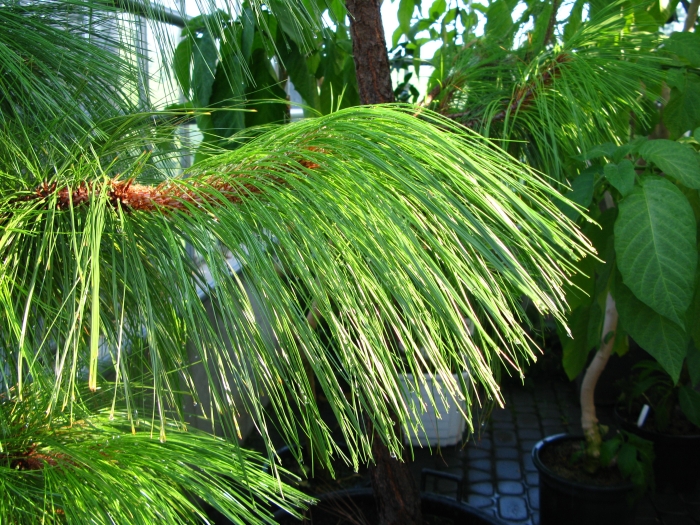Montezuma Pine
(Pinus montezumae)
Montezuma Pine (Pinus montezumae)
/
/

Crusier
CC BY 3.0
Image By:
Crusier
Recorded By:
Copyright:
CC BY 3.0
Copyright Notice:
Photo by: Crusier | License Type: CC BY 3.0 | License URL: https://creativecommons.org/licenses/by/3.0 | Uploader: Crusier | Publisher: Wikimedia Commons | Title: Pinus_montezumae_shoots_2_PAN.JPG | Notes: User created page with UploadWizard |















Estimated Native Range
Summary
Pinus montezumae, commonly known as Montezuma Pine, is an evergreen tree native to high-altitude pine-oak forests and cloud forests in Mexico and Central America. It can reach a height of 70-100 feet (21-30 meters) and a width of 30-40 feet (9-12 meters), with a straight trunk and a rounded to pyramidal crown. The Montezuma Pine is notable for its long, drooping needles that can be up to 18 inches long, arranged in bundles of five. It produces cones that are 8-16 inches long, among the longest of any pine species. The tree is also valued for its attractive bark, which is deeply furrowed and adds textural interest to the landscape.
Montezuma Pine is appreciated for its rapid growth rate and stately appearance, making it suitable for use as a specimen tree in parks and large gardens. It is also used for reforestation projects due to its adaptability. This species prefers full sun and can tolerate a range of soil types, provided they have slow to medium drainage. While it is generally low-maintenance, it can be susceptible to pine wilt disease and bark beetles. It is important to monitor for these potential problems to ensure the health of the tree. Montezuma Pine is not typically invasive when grown outside its native range, but care should be taken to plant it in appropriate settings to avoid any ecological imbalance.CC BY-SA 4.0
Montezuma Pine is appreciated for its rapid growth rate and stately appearance, making it suitable for use as a specimen tree in parks and large gardens. It is also used for reforestation projects due to its adaptability. This species prefers full sun and can tolerate a range of soil types, provided they have slow to medium drainage. While it is generally low-maintenance, it can be susceptible to pine wilt disease and bark beetles. It is important to monitor for these potential problems to ensure the health of the tree. Montezuma Pine is not typically invasive when grown outside its native range, but care should be taken to plant it in appropriate settings to avoid any ecological imbalance.CC BY-SA 4.0
Plant Description
- Plant Type: Tree
- Height: 70-100 feet
- Width: 30-40 feet
- Growth Rate: Moderate
- Flower Color: N/A
- Flowering Season: Non-Flowering
- Leaf Retention: Evergreen
Growth Requirements
- Sun: Full Sun
- Water: Medium
- Drainage: Slow, Medium
Common Uses
Bird Garden, Deer Resistant, Drought Tolerant, Fragrant, Low Maintenance, Rabbit Resistant
Natural Habitat
High-altitude pine-oak forests and cloud forests
Other Names
Common Names: Rough-Bark Mexican Pine, Rough-Barked Mexican Pine, Rough-Branched Mexican Pine, Montezuma-Kiefer, Ocote Blanco, Ocote Macho, Ocote Nembra, Pino Montezuma, Pino De Montezuma, Pino Gordo
Scientific Names: , Pinus montezumae, Pinus backhousiana, Pinus chalmaensis, Pinus cornea, Pinus depauperata, Pinus gordoniana, Pinus leroyi, Pinus ocote, Pinus pescatarei
GBIF Accepted Name: Pinus montezumae Lamb.